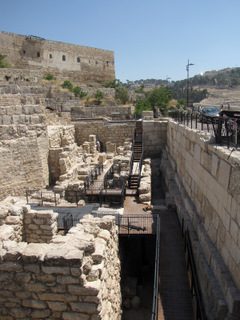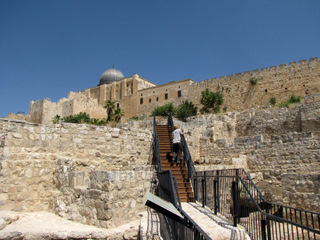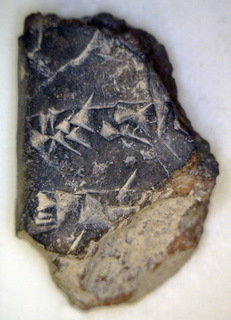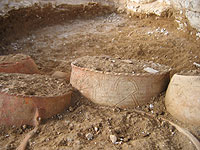By Jacqueline Schaalje
The Citadel of Jerusalem is better known as the Tower of David. Nowadays the fort is distinguished by its Islamic towers and entrance porch, but the Citadel's history goes back way before that. The Jewish historian Josephus first called the fortress the "Citadel of King David." The name "David's Tower" now refers to the minaret on the South side. To make things confusing the term "David's Tower" used to be reserved in the past for the north-east tower, whose origin is Herodian.
The oldest remains of a city wall and stronghold on the site, although not visible to current visitors, lies buried in the bedrock of the underlying hill. They date back to the monarchic period in Israel. King Hezekiah (end of 8th Century BCE) built a wall and towers after the Assyrian invasion of Judah (2 Chronicles 32:5). The wall was 7 meters wide, and constructed of large boulders. This giant wall was damaged during the Babylonian victory over Jerusalem in 587/6 BCE. In subsequent centuries the city shrunk back to the city of David on the eastern hill; consequently there was no need for a defence on the western hill.
The situation changed during the Hasmonean period. The city grew and extended to the western hill again. But although the Hasmonean kings already brought this part of the city inside the walls in the late second Century BCE, it was probably Herod who used the site for the first time to build a fort. Herod also erected his famous palace, which stretched to the south of the modern bastion. According to Josephus, Herod's palace was "wondrous beyond words." The palace was enormous and remains have been found where the Armenian garden is presently situated, which borders the south city wall.
The location was very suitable for a fort, as it was on the top of a hill, and according to Josephus the hill possessed an additional crest. Herod constructed 3 imposing towers to defend the wall, bastion and palace. They were called after his wife Mariamne, his friend Hippicus and his brother Phasael. It is the last tower which is still standing (the upper part of the tower is Islamic).

The palace and citadel remained a site of importance during the history of Israel. When the Romans assumed direct control over Palestine in 6 CE the Roman Procurator (governor) resided in the Herodian palace. According to the New Testament Jesus was judged here. Jewish "rebels" were summoned before the Roman ruler and were scourged and then crucified (as told in Josephus' War). The cruelty was one of the causes of the First Jewish War. In 66 CE Jewish rebels attacked and burnt the palace. According to Josephus "they dug a mine from a great distance and made it totter (War, 2:435)". Destruction layers coming from the attack were found in archaeological remains in the south of the courtyard, where once one of Herod's towers must have stood.
Four years later, the Roman general Titus conquered the city, burnt the Temple, and garrisoned his troops beside the remains of the destroyed palace. The Herodian towers were left standing. The Roman tenth legion camped on the site of Herod's old palace for 200 years.
The site of the fortress was named after the tower of David by the Byzantines, who thought Jerusalem's Western hill was Mount Zion, which was incorrectly identified with the city of David. The citadel was only reconstructed in its full glory in later centuries, exactly when is not known. During the early Arab period the Fatimids lost the citadel and Jerusalem to the Crusaders. The Crusader kings made the fortress their residence, and extended it further to the west. After the defeat of the Crusaders against the Arabic Saladin, the latter took seat in the citadel.
In subsequent centuries the Citadel was destroyed and built up many times. The Mamluk sultan Muhammad constructed the final form of the fortress in the 14th Century CE. He levelled the old city wall which until this time had run straight through the fortress. This division can easily be seen today, especially from a view from one of the towers. The old Hasmonean wall, which was strengthened by Herod and later rulers, runs north-east to south-west through the inner archaeological garden.
During the Mamluk period Jerusalem became neglected, and the Citadel was barely kept. After the Ottoman victory the sultan Suliman the Magnificent (16th Century), who also built the modern city walls, built the monumental entrance to the fortress, and the platform for cannon along the western wall. The Ottoman troops were stationed inside the city walls on the south side of the fortress (the location of Herod's palace). The remains of the Turkish camp are still visible at the base of the wall.
The minaret of the Citadel was built by Muhammad Pasha in the middle of the seventeenth Century. The mosque beside it was repaired by Suliman the Magnificent and was built on top of a Crusader hall. From the roof of the mosque the above-mentioned Turkish barracks can be seen against the wall.
After the city became once again Jewish, in the 20th Century, for the first time in its history the Citadel was not used anymore for strategic purposes. After archaeological study it was converted into a museum. The exhibition about the history of Jerusalem could not be on a more appropriate place, as the citadel was at once part and the highlight of the history of the city.
To make sense of the remains in the archaeological garden inside the courtyard of the fortress, it is a good idea to first study the exhibitions and film about Jerusalem inside the towers and the former mosque.
Also enlightening is a climb to the towers and ramps in order to look down at the archaeological garden. Turning one's gaze outside results in a magnificent view of the old city. At night this is very impressive: Jerusalem's monuments, including the Citadel itself, are placed in floodlights.
From the north-west tower, which looks down on Jaffa Gate, one looks at the medieval moat, which was filled in the late 19th Century. This tower also provides the best view on the excavations in the courtyard.
There are several ways to reach the courtyard, but through the main entrance is probably the most usual one. This is reached after passing the ornamental gate and the bridge. Both are from the time of Suliman the Magnificent, as Arabic inscriptions indicate.
It is also possible to pass under the bridge, by taking a flight of stairs beside the remains of a Byzantine wall. Following these one enters into the moat. Further south of the bridge used to be a quarry. Another flight of steps leads to a rock-cut water channel. Coins which were found in the plaster date it to the Hasmonean period.
By ascending again one comes through the main entrance, built by the Crusaders but restored by the Mamluks in the 14th Century. The main entrance room is in L-shape: this is so as to slow down possible attackers to the fortress. Original Crusader features are the stone benches in the guardroom and slits for the portcullis. From the hexagonal room the courtyard can be reached.
The curved Hasmonean wall, still reaching an impressive height of about 7 meters and 4 meters thick, divides the courtyard into two parts. This is the First Wall, as described by Josephus. Remains are traced also outside of the Citadel. To the south it runs beneath the present city wall where in ancient times it would have connected to the wall round the city of David. To the east traces of the First Wall are found in the Jewish Quarter; it stretched to the Temple Mount. Houses were built against the inner face of the wall; one of the entrances is still visible. Two towers were also built.
Herod thickened the Hasmonean wall, and added his three towers, of which only the Phasael tower is left, as described above. The Herodian part of the tower still measures 20 meters. The towers were built on an artificial platform to make them more imposing. The platform was made by intersecting walls which were lain over the Hasmonean houses beside the old wall, and the space in between was filled with earth filling. The existing Hasmonean towers were thickened, changed and extended. All of this construction, except for the Herodian new towers, was destroyed during the First Jewish War.
Not much has been found of the long Roman occupation of the site. In the Byzantine period a new wall was built which extended northwards from the Herodian tower; some steps are still visible. The new wall enclosed the old city on the north for the first time; the current northern city wall still follows the same course. The Byzantines also strengthened the existing Hasmonean/Herodian wall.
The Arab occupation after 638 brought significant changes. In following centuries a new round tower was erected, which may be located in the south-eastern corner of the courtyard. Probably this tower stood at the corner of a new wall, which ran north and south. If we assume that the Arabs left the Hasmonean/Herodian wall as their western limit, the outlines of the Arab fort become clear. This was the fortress that fell to the Crusaders in 1099.
The Crusaders clearly found the exsisting fortress too small to incorporate their royal court. They devised an imposing bastion and palace. Again the Herodian tower was left in place, which surely is a sign of its enduring quality. Also they strengthened again the old towers and the Herodian western wall, by adding a new wall to the west of it. Under the mosque in the south-west corner of the courtyard lies a Crusader chamber, which is reached by two medieval tunnels. One of the tunnels is entered from the courtyard.
The current outer walls and new towers in the north-west and south-east corners are from the later Arabic period. Although exact dates are unknown, inscriptions which were found at the main entrance, date its first construction to the time of sultan Muhammad in 1310. In the Herodian tower a cut at the end of the stairs shows that the Mamluk construction was simply superimposed on the Herodian remains. The smaller upper stones of the tower show a vast contrast with the solid blocks of Herod at the base of the tower; the last are built for eternity.
Only one construction in the courtyard could not be dated until now: in the northern part a row of small stones form a low rough wall. This could be either Roman or Herodian, but its function remains a mystery.



 A spectacular and extraordinary 2,000 year old gold and silver hoard was uncovered in an archaeological excavation conducted by the Israel Antiquities Authority in the Qiryat Gat Region. The treasure trove, comprising some 140 gold and silver coins as well as gold jewelry, was probably hidden by a wealthy woman at a time of impending danger during the Bar Kokhba Revolt (132 - 135 CE).
A spectacular and extraordinary 2,000 year old gold and silver hoard was uncovered in an archaeological excavation conducted by the Israel Antiquities Authority in the Qiryat Gat Region. The treasure trove, comprising some 140 gold and silver coins as well as gold jewelry, was probably hidden by a wealthy woman at a time of impending danger during the Bar Kokhba Revolt (132 - 135 CE).  According to the Israel Antiquities Authority Excavation Director archaeologist Emil Aladjem, "The magnificent hoard includes gold jewelry, among them an earring crafted by a jeweler in the shape of a flower and a ring with a precious stone on which there is a seal of a winged-goddess, two sticks of silver that were probably kohl sticks, as well as some 140 gold and silver coins. The coins that were discovered date to the reigns of the Roman emperors Nero, Nerva and Trajan who ruled the Roman Empire from 54-117 CE.
According to the Israel Antiquities Authority Excavation Director archaeologist Emil Aladjem, "The magnificent hoard includes gold jewelry, among them an earring crafted by a jeweler in the shape of a flower and a ring with a precious stone on which there is a seal of a winged-goddess, two sticks of silver that were probably kohl sticks, as well as some 140 gold and silver coins. The coins that were discovered date to the reigns of the Roman emperors Nero, Nerva and Trajan who ruled the Roman Empire from 54-117 CE.  and their quality are consistent with treasure troves that were previously attributed to the time of the Bar Kokhba Revolt. During the uprising, between 132-135 CE, the Jews under Roman rule would re-strike coins of the emperor Trajan with symbols of the revolt. This hoard includes silver and gold coins of different denominations, most of which date to the reign of the emperor Trajan. This is probably an emergency cache that was concealed at the time of impending danger by a wealthy woman who wrapped her jewelry and money in a cloth and hid them deep in the ground prior to or during the Bar Kokhba Revolt. It is now clear that the owner of the hoard never returned to claim it."
and their quality are consistent with treasure troves that were previously attributed to the time of the Bar Kokhba Revolt. During the uprising, between 132-135 CE, the Jews under Roman rule would re-strike coins of the emperor Trajan with symbols of the revolt. This hoard includes silver and gold coins of different denominations, most of which date to the reign of the emperor Trajan. This is probably an emergency cache that was concealed at the time of impending danger by a wealthy woman who wrapped her jewelry and money in a cloth and hid them deep in the ground prior to or during the Bar Kokhba Revolt. It is now clear that the owner of the hoard never returned to claim it." The treasure hoard was removed from the field and transferred for treatment to the laboratories of the Israel Antiquities Authority in Jerusalem. The jewelry objects will become part of our Jewelry collection in the Brandt-Lewis Family National Center for Ancient Jewelry, and the coins will become part of the Saul Fox National Coin Center, in the Schottenstein National Campus for the Archaeology of Israel under construction in Jerusalem.
The treasure hoard was removed from the field and transferred for treatment to the laboratories of the Israel Antiquities Authority in Jerusalem. The jewelry objects will become part of our Jewelry collection in the Brandt-Lewis Family National Center for Ancient Jewelry, and the coins will become part of the Saul Fox National Coin Center, in the Schottenstein National Campus for the Archaeology of Israel under construction in Jerusalem.



 The staff of the Saul A. Fox National Coin Center performs a wide range of tasks, both scientific and curatorial. Its members specialize in the identification, registration and scientific publication of coins found in excavations. Additional duties include lectures and scientific consultation for researchers and archaeologists; preparation of coin exhibits in Israel and abroad and preparation of educational material.
The staff of the Saul A. Fox National Coin Center performs a wide range of tasks, both scientific and curatorial. Its members specialize in the identification, registration and scientific publication of coins found in excavations. Additional duties include lectures and scientific consultation for researchers and archaeologists; preparation of coin exhibits in Israel and abroad and preparation of educational material. Interior of the Belz Grand synagogue in Jerusalem, widely considered the largest synagogue in the world.
Interior of the Belz Grand synagogue in Jerusalem, widely considered the largest synagogue in the world. Interior of the Santa Maria La Blanca Synagogue in Spain. Built during the 'Golden Age' of Spain (prior to the expulsion of Jews in 1492), it shows heavy Moorish influence in its style of architecture.
Interior of the Santa Maria La Blanca Synagogue in Spain. Built during the 'Golden Age' of Spain (prior to the expulsion of Jews in 1492), it shows heavy Moorish influence in its style of architecture.
